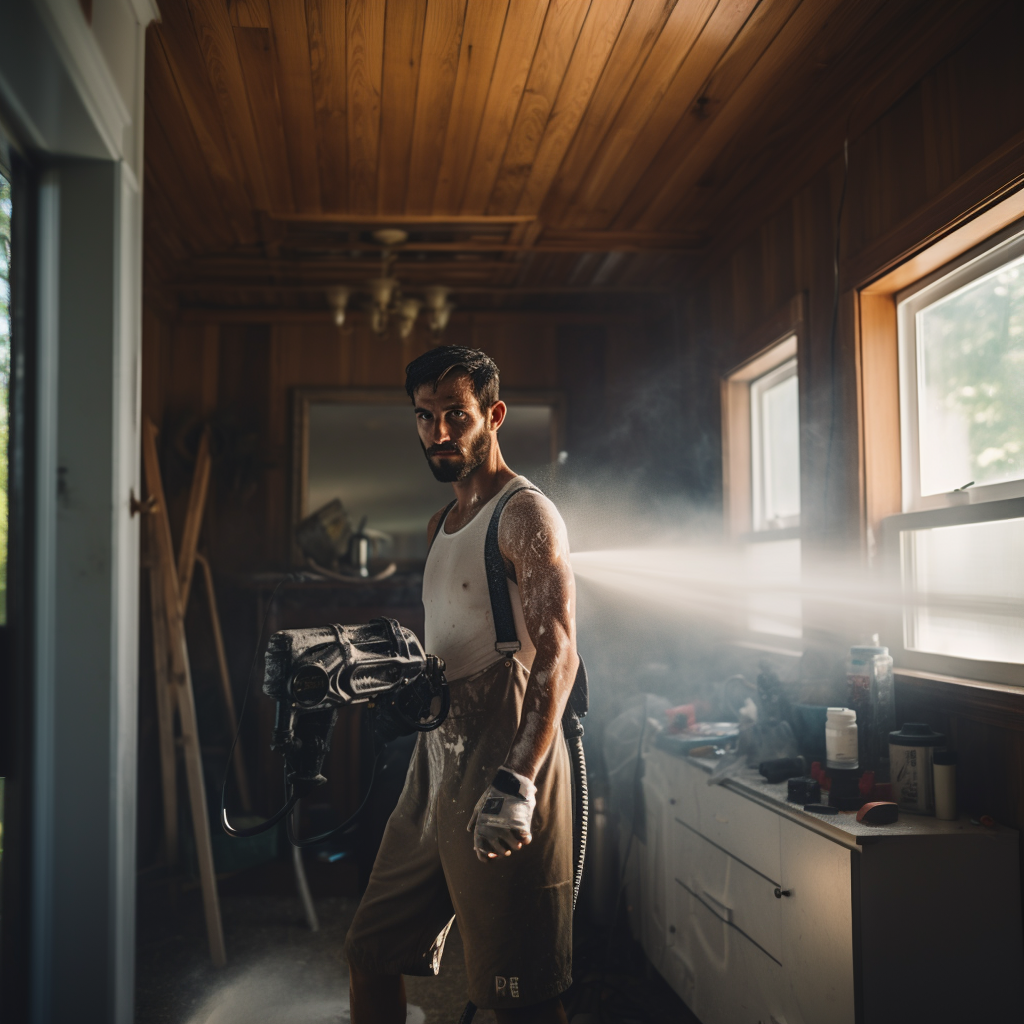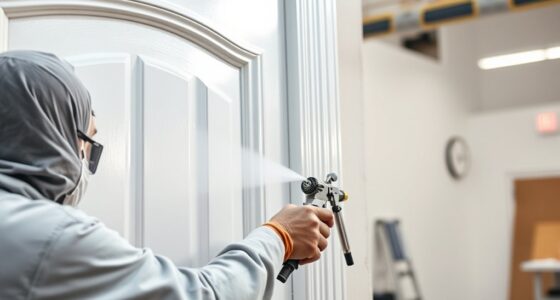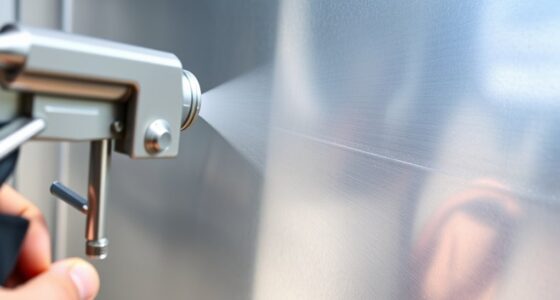When spray painting, you should wear proper PPE like a well-fitted respirator with filters suited for fumes, chemical-resistant gloves, and eye protection such as goggles or face shields. Make certain your workspace has good airflow by using exhaust fans or open windows to prevent fumes from building up. Organize your area for safety and proper ventilation, and always stay alert to symptoms of overexposure. Keep yourself and your workspace safe—more tips are just ahead.
Key Takeaways
- Always wear properly fitted respiratory protection with appropriate filters for vapors and particulates during spray painting.
- Use chemical-resistant gloves and full-body clothing to prevent skin contact and chemical absorption.
- Ensure workspace has adequate ventilation with fans or open windows to disperse fumes effectively.
- Arrange workspace to promote good airflow, keep it organized, and keep flammable materials away from spray zones.
- Regularly inspect and maintain PPE and ventilation systems to ensure safety and optimal protection.
Choosing the Right Respiratory Protection
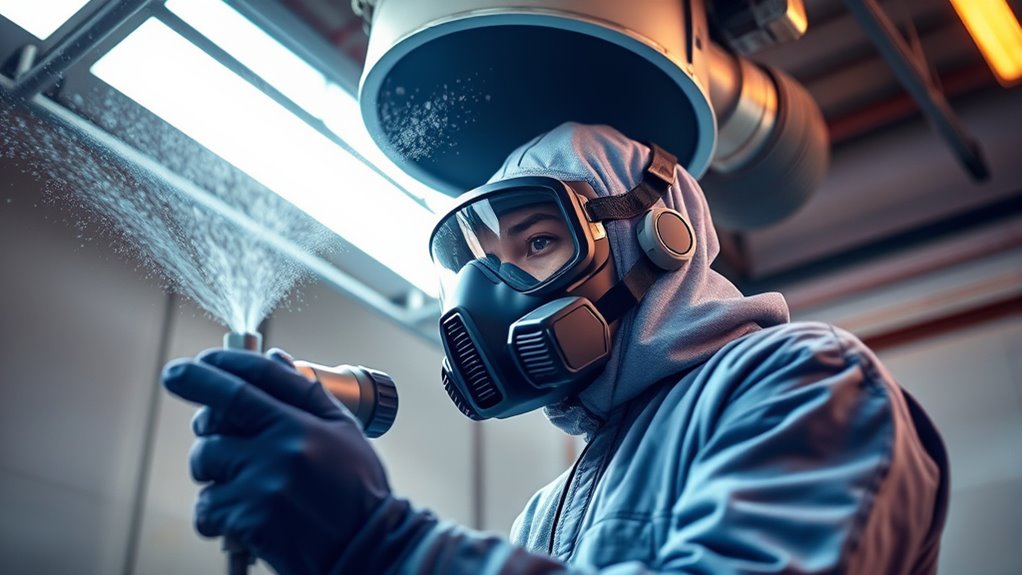
Choosing the right respiratory protection is essential to staying safe while spray painting. You need to guarantee your respirator fits properly to prevent airborne paint particles and fumes from entering your respiratory system. A good fit means a snug seal around your face without discomfort, which enhances protection and reduces leakage. When selecting a respirator, consider filter types; some masks use particulate filters for solids, while others include chemical cartridges for vapors and fumes. Make sure the filter matches the specific hazards of your project. Always check the respirator’s fit and filter compatibility before starting, and replace filters regularly to maintain efficacy. Proper respiratory protection keeps you safe from inhaling harmful substances during spray painting.
Wearing Appropriate Clothing and Gloves
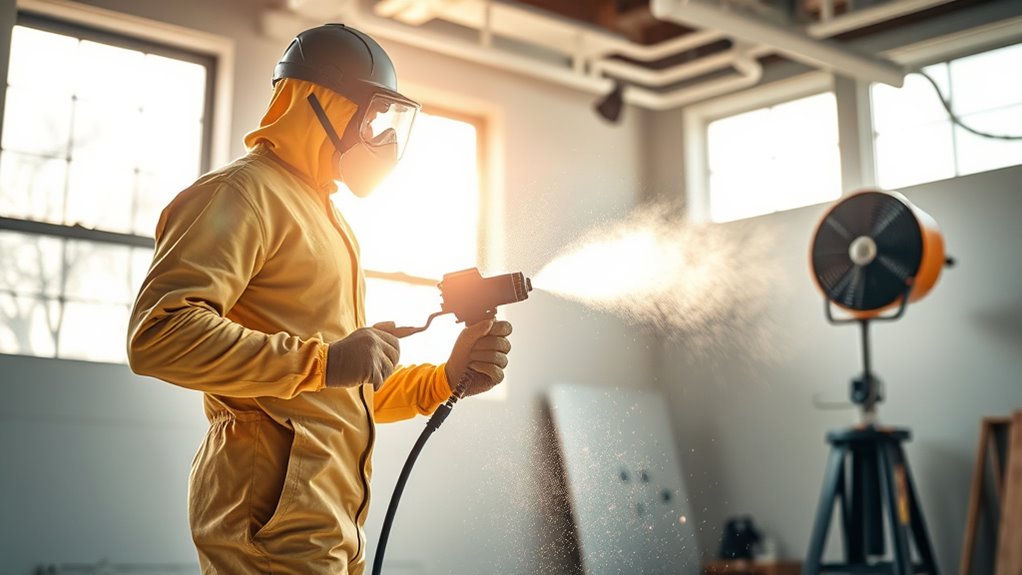
Wearing appropriate clothing and gloves is essential for protecting your skin from paint splatters, fumes, and chemical exposure during spray painting. Choose protective clothing that covers your arms and legs to minimize skin contact with paint and chemicals. Long sleeves, pants, and coveralls made of durable, chemical-resistant materials provide an effective barrier. Always wear chemical resistant gloves to prevent direct contact with hazardous substances. These gloves help avoid skin irritation and chemical absorption, especially when handling paints and solvents. Ensure the gloves fit well and are in good condition before starting. Proper protective clothing and gloves also help prevent accidental contact with fumes, reducing potential health risks. Regular use of exfoliating acids can enhance skin resilience and recovery from exposure. Additionally, selecting appropriate materials designed for chemical resistance can further improve safety and durability during the task. Proper ventilation practices are also crucial to reduce inhalation of toxic fumes and ensure a safer working environment. By wearing the right protective clothing and gloves, you reduce your risk of injury and exposure, making your spray painting process safer and more comfortable. Using personal protective equipment (PPE) that is suitable for chemical handling further minimizes health hazards associated with spray painting.
Eye and Face Safety Measures

Protecting your eyes and face is essential when spray painting. You should always wear proper eye protection gear and consider using a face shield to block paint splatters and fumes. These safety measures help prevent injuries and make sure you work safely. Additionally, wearing appropriate Personal Protective Equipment (PPE) can further reduce exposure to harmful fumes and particles. Using PPE designed for paint fumes is especially important for prolonged projects or poorly ventilated areas. Being aware of proper ventilation techniques can also significantly decrease inhalation of toxic substances. Properly maintaining and inspecting your protective gear ensures it functions effectively during your projects.
Proper Eye Protection Gear
Since spray painting involves airborne particles and fumes, ensuring proper eye protection is essential for safety. Wearing safety glasses or protective goggles keeps your eyes shielded from overspray, splatters, and harmful fumes. Safety glasses should fit snugly and have side shields to prevent particles from entering from the sides. Protective goggles offer more thorough coverage, especially in environments with high spray activity or when working for extended periods. Always select eye protection that meets safety standards and is appropriate for the specific type of spray paint you’re using. Never compromise on eye safety, as even small particles can cause irritation or long-term damage. Proper eye protection minimizes risks and helps you work confidently and safely. Safety standards should guide your choice of protective gear to ensure maximum protection.
Face Shield Usage Importance
Because spray painting releases airborne particles and fumes that can easily reach your face and eyes, using a face shield is a crucial safety measure. The face shield benefits include protecting you from splashes, dust, and harmful fumes. When selecting a face shield, consider these factors:
- Clear, impact-resistant visor for visibility.
- Adjustable headbands for a secure fit.
- Full-face coverage to guard your eyes, nose, and mouth.
- Compatibility with other PPE like masks and respirators.
- Ensuring proper ventilation during spray painting helps reduce inhalation of fumes and enhances safety. Proper protective equipment like a face shield minimizes exposure to hazardous airborne particles, ensuring safety during spray painting. Proper air filtration can further improve safety by reducing airborne contaminants in the workspace. Additionally, understanding fire safety regulations related to spray painting environments can prevent accidents and ensure compliance. Choosing the right face shield ensures maximum protection and comfort during spray painting. It’s important to prioritize face shield benefits and select a model suited to your needs. Proper face shield usage minimizes risks, keeping you safe from potential hazards associated with airborne particles and fumes.
Ensuring Proper Workspace Ventilation

Proper workspace ventilation is essential to safely spray paint and minimize health risks. To achieve this, focus on airflow optimization by using fans, exhaust systems, or open windows to promote continuous air movement. Good airflow helps disperse fumes and overspray, reducing inhalation hazards. Additionally, organize your workspace efficiently—keep clutter minimal and position your spray area away from confined spaces. Proper workspace organization ensures unobstructed airflow and prevents accidental spills or blockages that hinder ventilation. Always check that vents and exhaust fans are functioning correctly before starting. Ensuring proper airflow facilitates the dispersal of volatile compounds and enhances overall safety. Incorporating ventilation systems designed for industrial or workshop use can further improve air quality. Remember, well-ventilated spaces not only improve safety but also help achieve a smoother, more professional finish. Proper airflow is especially important in Water Parks, where large crowds and extensive water features can complicate ventilation efforts. Proper workspace setup and ventilation are crucial for a safe and effective spray painting process.
Setting Up a Safe Spray Painting Environment
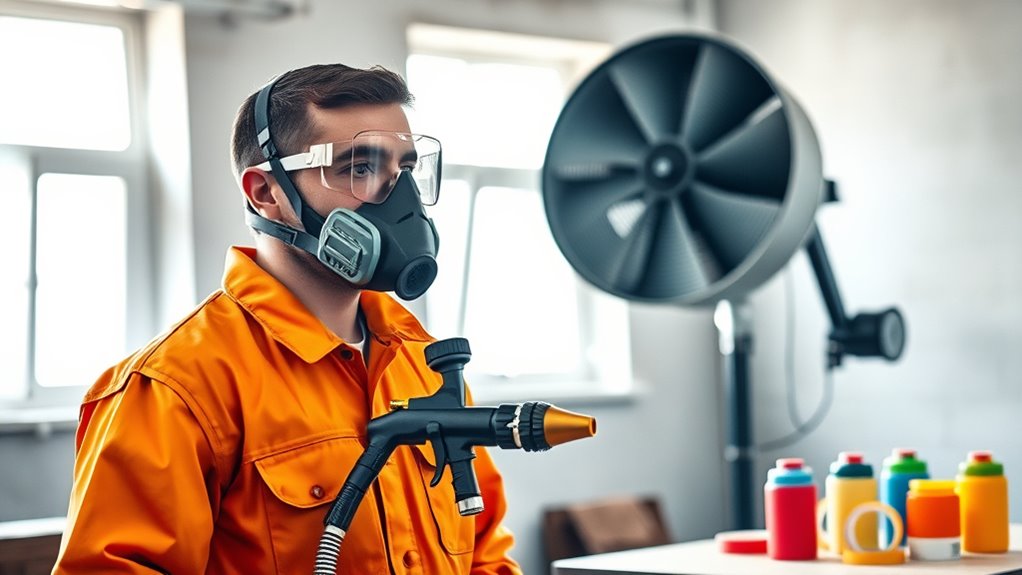
To establish a safe spray painting environment, you need to arrange your workspace properly to keep hazards at bay. Make sure your area allows for good airflow by establishing an adequate ventilation setup. This will help protect you from fumes and ensure a safer painting process. Additionally, regularly check your ventilation system to prevent hazardous fumes from accumulating. Creating a well-ventilated space is a key factor in best restaurants and maintaining a safe environment. Proper personal protective equipment is also essential to safeguard against inhaling fumes and contact with chemicals, further enhancing safety. Incorporating air circulation techniques can further improve the safety and effectiveness of your spray painting setup. Moreover, embracing a mindset that views failure as a learning opportunity can help you develop better safety habits over time.
Proper Workspace Arrangement
Setting up a safe spray painting environment starts with organizing your workspace to minimize hazards and guarantee proper airflow. Good workspace organization helps prevent accidents and makes hazard identification easier. To achieve this, focus on:
- Clearing clutter to prevent tripping or accidental contact with paint.
- Designating specific areas for tools, paints, and waste to avoid spills.
- Keeping flammable materials away from the spray zone.
- Ensuring your workspace has adequate space for movement and setup.
- Incorporating proper ventilation and avoiding confined spaces to reduce inhalation risks ventilation practices.
- Regularly inspecting your workspace for potential hazards and ensuring safety measures are maintained safety measures.
Adequate Ventilation Setup
Ensuring adequate ventilation is essential for safe spray painting, as it helps disperse harmful fumes and overspray effectively. You should set up proper ventilation systems that promote continuous airflow, preventing fumes from accumulating. Position exhaust fans or vent hoods strategically to maximize airflow management, directing fumes away from your work area and toward safe exhaust points. Open windows and doors to supplement mechanical systems, creating a cross-ventilation effect. Keep the workspace well-ventilated throughout your project, monitoring airflow to guarantee it remains consistent. Proper ventilation setup not only reduces health risks but also improves paint finish quality by preventing overspray buildup. Always test your ventilation system before starting, and adjust fans or vents as needed to maintain ideal airflow for a safer spray painting environment.
Handling and Disposing of Paint Safely
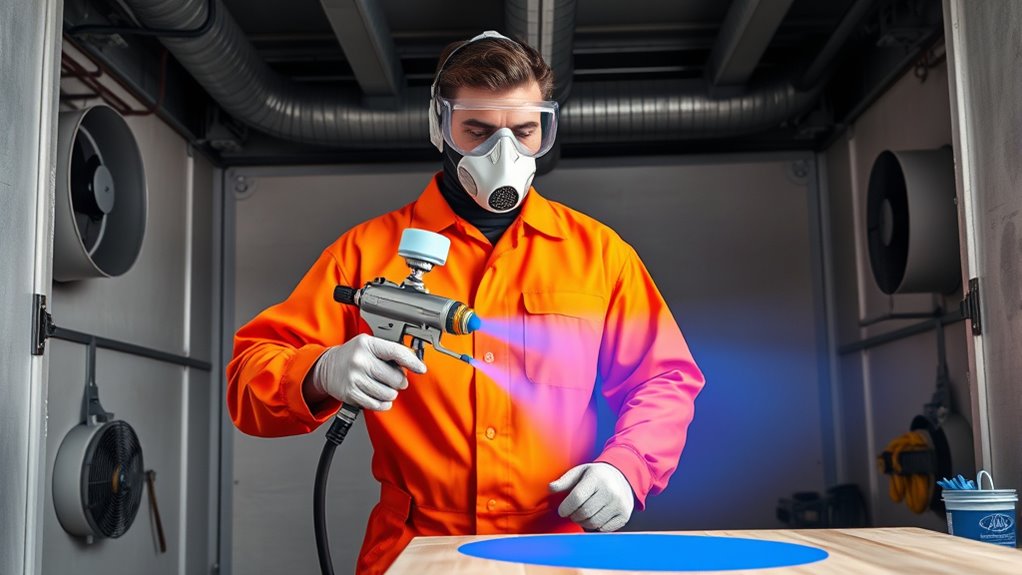
Handling and disposing of spray paint safely is essential to avoid health risks and environmental harm. When paint mixing, ensure you’re in a well-ventilated area and use appropriate PPE. Proper surface preparation prevents excess paint and reduces waste. To dispose of leftover paint or empty containers, follow these steps:
- Store unused paint in sealed, labeled containers for future use.
- Do not pour paint down drains or onto the ground.
- Contact local waste disposal services for hazardous waste collection.
- Recycle empty spray cans according to local regulations.
Always read manufacturer instructions for disposal guidance. Avoid leaving leftover paint exposed to heat or open flames. Proper handling minimizes environmental impact and keeps your workspace safe.
Recognizing Signs of Overexposure to Fumes
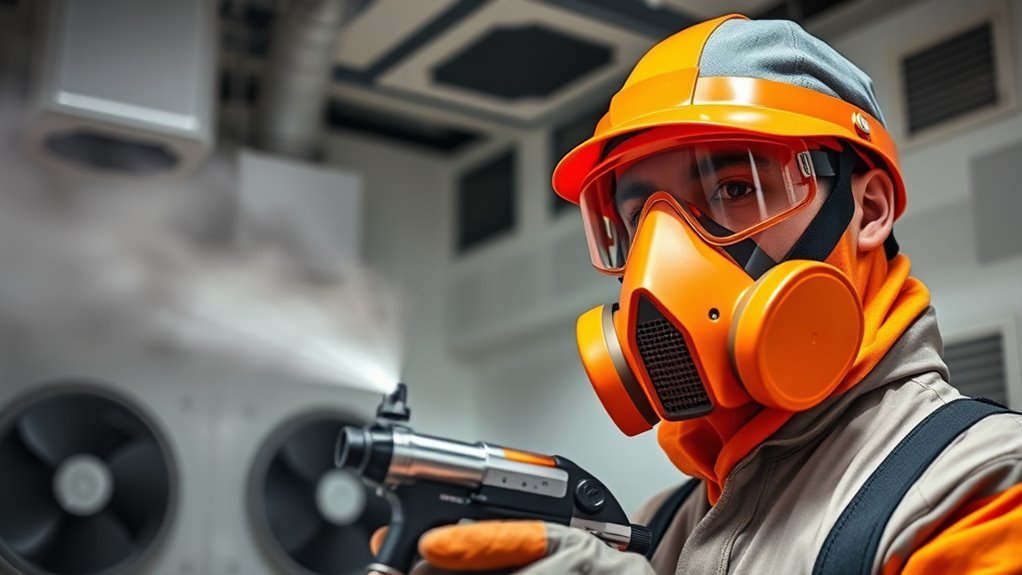
Being aware of the signs of overexposure to spray paint fumes is essential for your health. Fume symptoms can develop quickly, signaling that you need to take action. Common overexposure signs include dizziness, headaches, and nausea, which may feel like mild discomfort at first but can worsen without prompt care. Recognizing these symptoms early helps prevent serious health issues.
| Feeling lightheaded | Nausea or vomiting | Shortness of breath |
|---|---|---|
| Headache | Dizziness | Fatigue |
| Blurred vision | Chest tightness | Loss of coordination |
If you notice any of these signs, immediately remove yourself from the area and seek fresh air. Ignoring overexposure signs can lead to long-term health risks.
Maintaining Your PPE and Workspace Safety
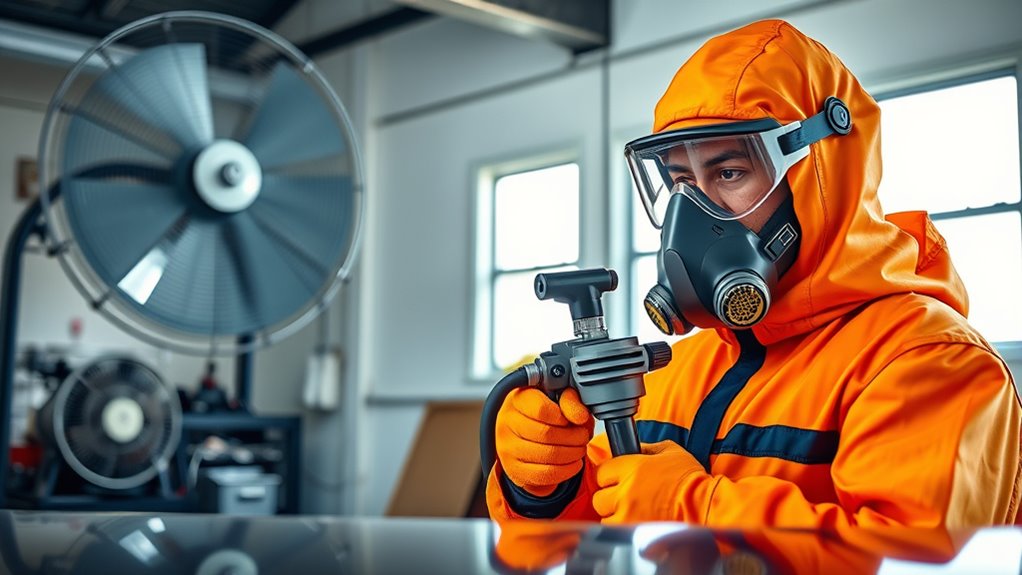
Recognizing the signs of overexposure highlights the importance of keeping your personal protective equipment (PPE) in good condition and your workspace safe. Regularly inspect your protective eyewear for cracks or scratches and replace damaged gear immediately. Maintain workspace cleanliness by cleaning spills, removing debris, and organizing tools to prevent accidents. To ensure safety, follow these steps:
- Check PPE seals and integrity daily before use.
- Store protective eyewear in a clean, dry place.
- Discard or repair worn-out PPE promptly.
- Keep your workspace free of dust, paint drips, and clutter.
Additional Tips for Safe Spray Painting Practices

To guarantee safe spray painting, always work in a well-ventilated area to avoid inhaling harmful fumes. Regular spray gun maintenance is essential; clean your equipment thoroughly after each use to prevent clogs and ensure smooth operation. Proper spray gun adjustment also helps reduce overspray and waste, making your project safer and more efficient. When selecting paint colors, choose high-quality, low VOC options to minimize harmful emissions. Test your spray gun on a scrap surface before starting your project to ensure even coverage and avoid mishaps. Keep your workspace organized to prevent accidents, and always follow manufacturer instructions for equipment and paint use. These extra precautions will help you achieve professional results while maintaining a safe environment.
Frequently Asked Questions
How Often Should I Replace or Upgrade My PPE?
You should replace or upgrade your PPE regularly to guarantee safety. Pay attention to PPE maintenance and inspect your safety equipment lifespan frequently. If you notice any tears, deterioration, or loss of effectiveness, it’s time for an upgrade. Even if equipment looks fine, replace it after a certain period—usually every 1-5 years—based on usage and manufacturer recommendations. Proper maintenance and timely upgrades keep you protected during spray painting.
Can Children or Pets Be Exposed to Spray Painting Fumes?
You might wonder if children or pets can be exposed to spray painting fumes. Child safety and pet protection are vital, so it’s best to keep them away from the area during and immediately after painting. Fumes can be harmful to their health, causing respiratory issues or other problems. Always guarantee proper ventilation, and only allow children and pets back once fumes have fully dissipated for their safety.
What Are the Signs of PPE Degradation Over Time?
Think of PPE like a trusted shield—over time, it wears down. You might notice tears or thinning material, signaling PPE material wear, or see chemical residue buildup that reduces its effectiveness. If your respirator’s filters become clogged or straps loosen, it’s time to substitute them. Recognizing these signs ensures you stay protected from fumes and hazardous particles, keeping your safety gear reliable during every spray painting session.
Are There Eco-Friendly or Non-Toxic Spray Paint Options?
You’ll find plenty of eco-friendly paints and non-toxic options that are safe for you and the environment. Look for brands that use water-based formulas, low or zero VOCs, and natural ingredients. These paints reduce harmful emissions and are easier to clean up. By choosing eco-friendly paints, you protect your health and contribute to a greener planet, making your spray painting projects both safer and more sustainable.
How Do I Store Spray Paint and PPE Safely When Not in Use?
Imagine your workspace filled with potential hazards, yet safe storage can prevent accidents. When you store spray paint, keep it in a cool, dry place away from heat sources to avoid leaks or explosions—this is storage safety. For PPE, make sure it’s clean and dry to maximize its lifespan, guarding your health on every project. Proper storage protects your tools and safety gear, giving you peace of mind and a safer, more efficient painting experience.
Conclusion
By following these safety tips, you’ll turn your spray painting project into a fortress of protection—imagine a bubble of safety so strong, fumes bounce off harmlessly, and accidents vanish into thin air. With proper PPE, ventilation, and cautious handling, you’ll create a workspace so safe, it’s like painting inside a fortress of steel. Stay vigilant, stay safe, and turn every spray into a masterpiece without risking your health!
Franz came aboard the Paint Sprayer Zone team with a background in both journalism and home renovation. His articulate writing style, combined with a passion for DIY projects, makes him an invaluable asset. Franz has a knack for breaking down technical jargon into easy-to-understand content, ensuring that even the most novice of readers can grasp the complexities of paint sprayers.


